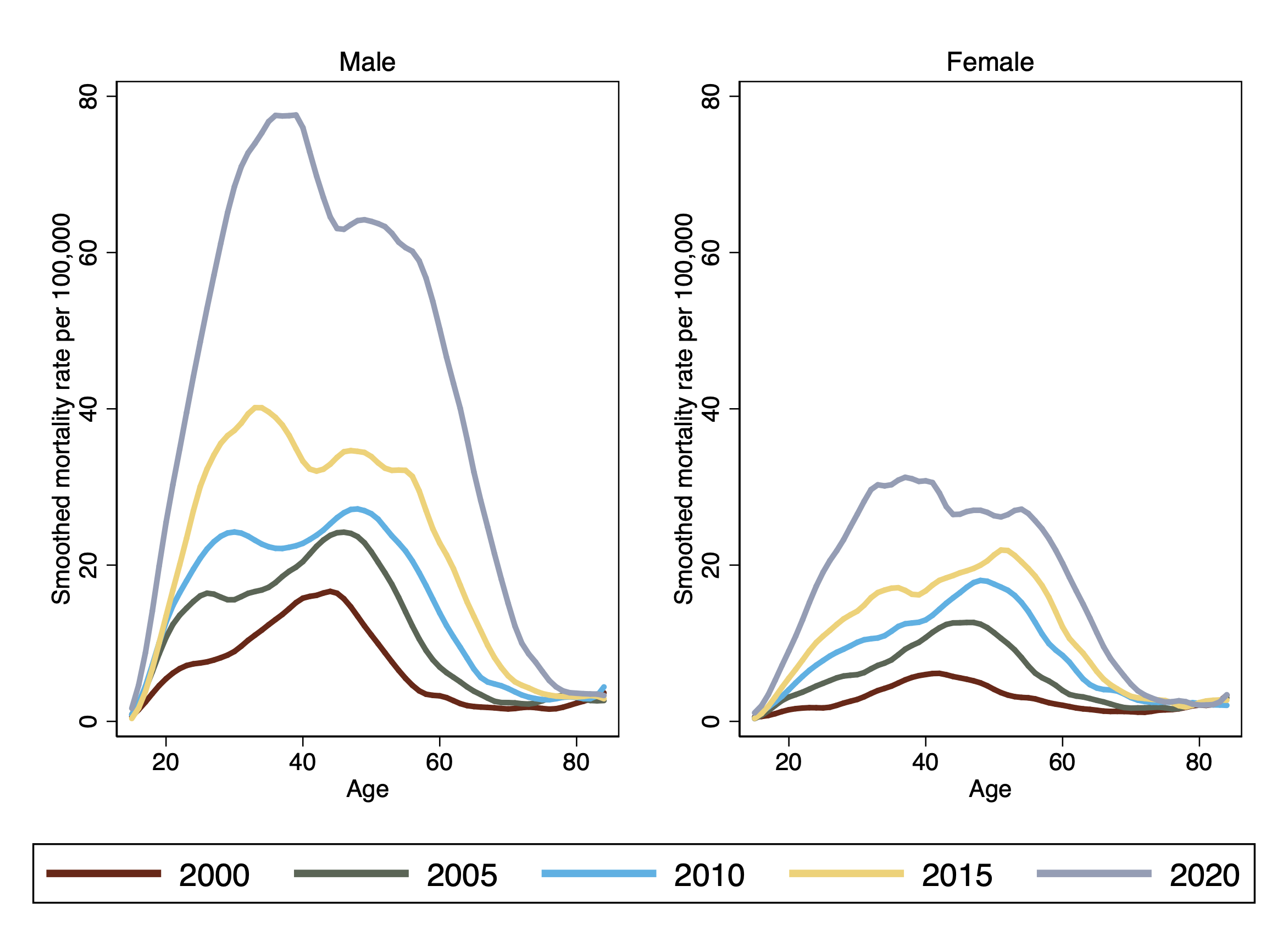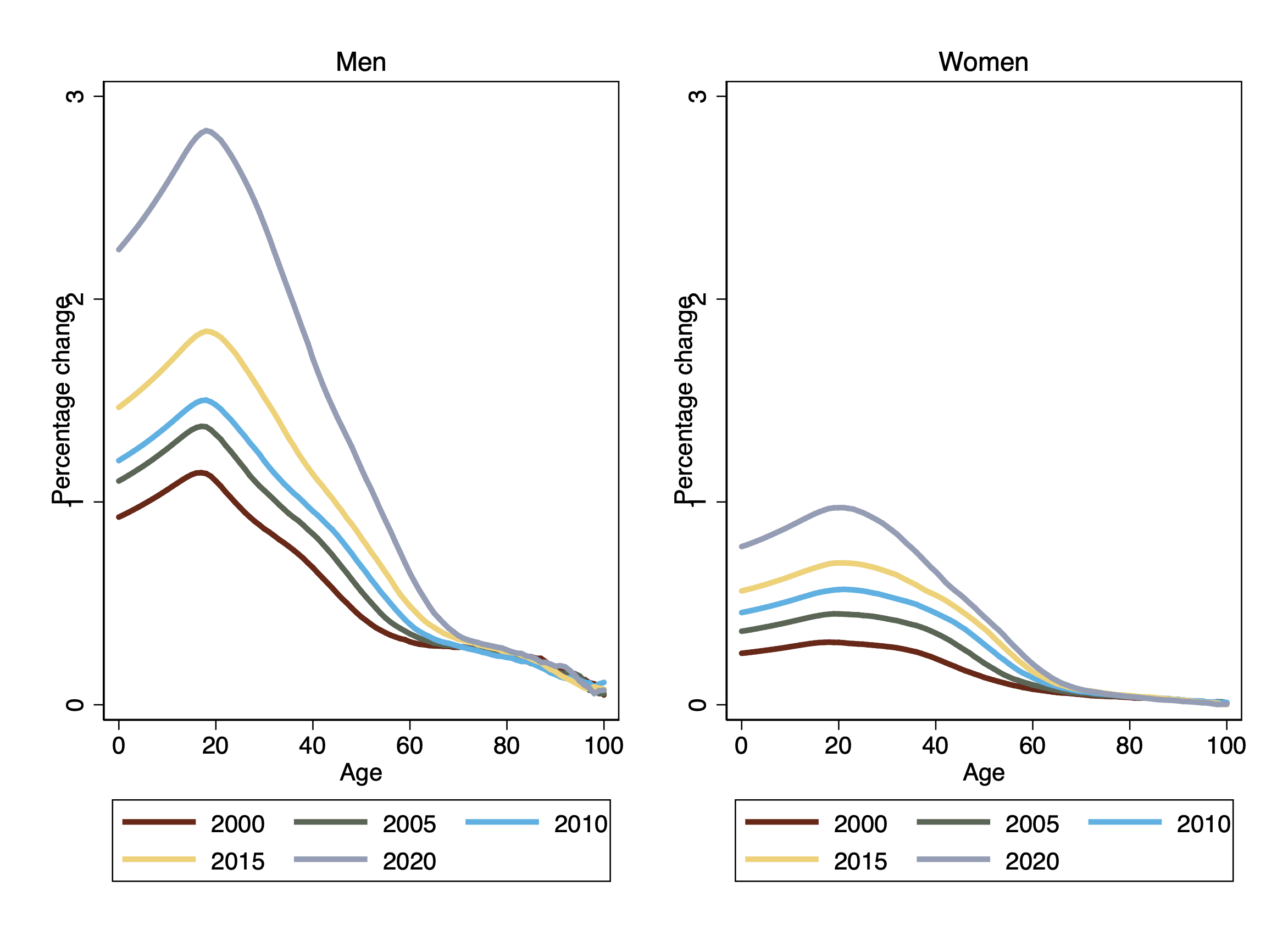Research Project: God, Guns and Drugs
This project began in 2022 as a master's student's research topic, and has expanded to become a wide-reaching assessment of the epidemiology of firearms and drug-related mortality in the USA. God, guns and drugs was the working title of the Master's student's research while we tried to figure out what direction to take it, and has since stuck as the project has expanded to include colleagues at several Japanese universities and Sun Yat Sen University in Guangzhou, China.
Introduction
The USA is facing a unique combination of health risks from opioid addiction, firearm deaths, and road injuries. While the rest of the high-income world either doesn't have these problems, or is seeing stable or downward trends in all of them, the USA is seeing deaths due to all of these causes rising, in some cases rapidly.
These causes are also unusual in public health because they are related to phenomena that elicit strong opinions on moral or principled grounds, especially in the USA. The right to drive whatever and however you like, the right to own firearms without restriction, and a strictly moralistic approach to drug use, make these health problems particularly difficult to prevent, especially in the context of America's poorly-performing health system. This makes responding to these crises politically challenging, and has enabled them to grow to become huge problems in the USA.
One side-effect of the insinuation of politics and morality into this health debate has been a lack of understanding of the epidemiology of the problems. Although the US medical and public health literature is replete with calls for more research on the epidemiology of gun deaths, there is very little actual practical research on this issue. Similarly, detailed epidemiological assessments of the changing patterns of opioid deaths are also lacking.
Seeing this, my colleagues and I decided to take on the challenge of understanding how these patterns of death are changing in the USA, nationally and at the state level, and try to contribute to debates about possible solutions through our independent, non-American perspective.
Objectives
The key goal of this project is to understand the patterns of mortality due to firearms and opioids (heroin, prescription painkillers and now fentanyl) in the USA. We aim to do this through the use of comprehensive mortality data from the US Centers for Disease Control.
Major research components
Our primary research theme in this project is the analysis of mortality data from two causes: firearms and opioids.
- Firearm deaths means deaths due to guns, either in suicide, homicide or by accident.
- Opioid deaths includes prescription opioids like oxycontin, illicit drugs like heroin, and more recently the synthetic opioids like fentanyl
We use data from the CDC Wonder website, which provides information on the number of deaths in each age group, sex and race category, nationally and by state, for every year since 2000. The data is given in detail by cause, so we can distinguish between, for example, accidental deaths due to firearms in children, and suicide deaths due to fentanyl.
Some of the major work we have been conducting so far is listed below.
Cohort trends in drug overdose deaths
People's health is typically affected by the current situation they are experiencing, and also by the particular historical details of their birth. For example, people born in the 1970s experienced particular patterns of socialization, environmental health exposures (such as lead in the atmosphere) and infectious disease risks which affect their health now; but they also experience similar current social and environmental risks to people born before or after them. The phenomena affecting health that are particular to this generation are called cohort effects, and the phenomena affecting everyone's health at the same point in time are called period effects. We want to understand the difference between these effects, so we can identify what part of a person's health risks might be due to current, changeable circumstances, and what might be specific to their cohort and social experiences.
We used a method called age-period-cohort modeling (APC modeling) to try to understand this phenomenon as it affects drug overdose deaths in the USA. This research was recently published in The Lancet eClinical Medicine, and showed that Americans born in recent generations - around about the turn of the millennium - face much higher risk of death due to drug overdoses than people born in earlier decades.
Trends in firearm and drug deaths
A basic part of our research on US mortality rates is to understand how trends in firearm and drug deaths are changing, and to identify what the effects of these changes might be. Figure 1 shows the age profile of drug-related mortality in the USA, from which we can see clearly that drug deaths have increased rapidly since 2000, and also that the rate has increased fastest in the youngest people.
Figure 1: Age profiles of drug-related mortality in the US since 2000

We are also using novel methods such as joinpoint regression to understand how firearm mortality has been changing over time, and are looking at these mortality rates at both the national and the state level. Understanding these differences helps to develop policy to change them.
Suicide by method and race
The USA also faces huge public health problems arising from firearms, and the widespread availability of firearms can have significant ramifications for suicide mortality. Many methods of suicide (such as poisoning or gas) can be relatively ineffective, and incomplete suicide attempts offer opportunities for intervention to prevent suicide death. Firearms, however, are extremely likely to be fatal, and easy access to firearms increases the risk that suicide attempts will become suicide fatalities.
However, in the USA, despite the widespread availability of guns, firearm suicide death rates vary significantly over time and by race and sex. We conducted a short analysis of mortality data by race and sex and published it in the Annals of Internal Medicine, showing that White and Native Americans have much higher firearm mortality rates than other races, and that these rates were much higher in men than women. Although guns are easily available in the USA, their use varies by race. This supports the general finding that the use of firearms for suicide reflects cultural and social differences as well as availability. Given the absence of serious gun control efforts in the USA, this does suggest that suitably tailored interventions could work to reduce suicide mortality in some groups, without necessarily restricting access to firearms.
Effect of firearms and drugs on life expectancy
Life expectancy - the average length of time a person can expect to live at any given age - is an important measure of the effectiveness of health systems. It is particularly affected by deaths in infants and among young people, and firearm and drugs deaths are therefore likely to reduce life expectancy when they reach a certain level. We have published research estimating the effect of guns and drugs on life expectancy in the US population. We found that in men, guns and drugs combined reduced life expectancy by 1.6 years in 2020 - the same effect as COVID-19 - and that the biggest life expectancy loss was in young people. Figure 2 shows the percentage loss in life expectancy at each age for men and women, in different years. In recent years among young men, in particular, these two preventable causes of death have been causing huge public health effects that are now identifiable at a population level through life expectancy loss.
Figure 2: Percentage of life expectancy lost at each age for men and women in selected years since 2000

American life expectancy has been stagnant for the past 10 years, and until these preventable causes of death are dealt with, it will not rise and may even begin to fall. Young Americans, in particular, can look forward to a future in which their health outlook continues to deteriorate.
Policy implications
Australia faced similar challenges with firearms in the 1980s, and with drug-related overdose death in the 1990s. When I worked in drug and alcohol research in Australia we viewed our drug-overdose fatality rate as a national emergency. Even though the mortality rate was lower than it is in the USA now, it led to a massive, nation-wide effort to prevent these deaths. The mortality rate peaked in mid-1990s, and policy responses at that time included:
- The convening of a "drug summit" in the largest state, New South Wales, to debate a comprehensive policy response
- Action at state level to increase access to methadone treatment, which is the only effective strategy to prevent overdose death
- The opening of the Sydney Medically Supervised Injecting Centre in 2001, with the goal of preventing overdose deaths
- Enhanced customs and police activity to prevent importation and distribution of drugs, including through agreements with neighbouring countries, leading to the famous "heroin shortage" of 2001, and its associated reduction in deaths
Similarly, in the 1980s and early 1990s Australia introduced comprehensive gun control policies, and implemented a massive nationwide anti-suicide campaign that was highly effective in reducing deaths by the mid-1990s.
None of these policy actions have been taken in the USA, which continues to debate the effectiveness and morality of basic measures that have been taken in almost every other country that faces severe drug or firearm problems. Until the USA implements some of these policies, it will continue to face a growing burden of preventable death due to firearms and drugs. Some actions it needs to take include:
- Effective nationwide anti-violence and anti-suicide campaigns
- Implementation of effective gun control policies at national and state level
- Measures to prevent corruption, enhance inter-operation, and improve the professionalism of police
- Anti-poverty and anti-racism measures that actually work, at individual and community level, to address the relationship between inequality and these preventable causes of death
- National- and state-level policies to improve access to methadone treatment, to reduce the punishment of low-level drug crimes, and to ensure continuity of care between the community and prisons
Until these policies are in place, the USA will face a high and growing burden of deaths due to these causes, which will ultimately degrade its population-level health outcomes, especially in the current generation of young Americans.
Publications
This project is ongoing, with more research papers to be published, but so far we have published our research in both peer-reviewed journals and in conferences.
Peer-reviewed papers
Fujita-Imazu S*, Gilmour S*, Wang Y, Xie J, Dhungel B, Wang X, Nguyen P, Khin Maung Soe J, Ota E, Biva NA, Li J. The effect of drugs and guns on life expectancy in the United States, 2000-2020. Public Health. 2024; 237: 193-197. Abstract
Fujita-Imazu S, Xie J, Dhungel B, Wang X, Wang Y, Nguyen P, Khin Maung Soe J, Li J, Gilmour S. Evolving trends in drug overdose mortality in the USA from 2000 to 2020: An age-period-cohort analysis. Lancet eClinical Medicine. 2023; 61:102079 Full text
Dhungel B, Shand F, Nguyen P, Wang Y, Fujita-Imazu S, Khin Maung Soe J, Xie J, Wang X, Li J, Gilmour S. Method-specific suicide mortality in the United States in the 21st Century. Annals of Internal Medicine. 2023;177(1): 110-133. Full Text
Conference presentations
Khin Maung Soe J, Nguyen P, Wang Y, Dhungel B, Fujita-Imazu S, Xie J, Wang X, Li J, Gilmour S. Changing trends in US firearm mortality over the past two decades: A joinpoint regression analysis. The 55th Asia Pacific Academic Consortium for Public Health Conference. Busan, Korea, October 23-25, 2024.
